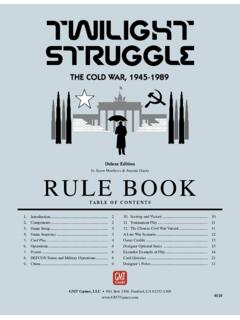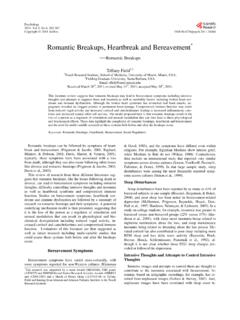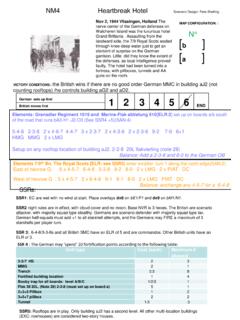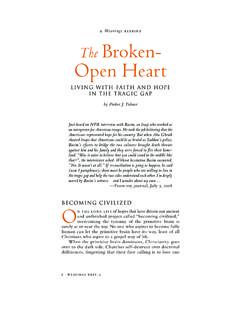Transcription of BAckgrOund - GMT Games
1 1 Fields OF Fire heartbreak ridgeBAckgrOund The Korean War started in June 1950. Partitioned after World War II with the North under Soviet sponsorship and the US in the South, mixed signals led the North Korean and Soviet leadership to believe the US would not contest the attack. The US was woefully unprepared, but President Truman decided to stand against the ag-gression. The Republic of Korea (ROK) forces were no match for the well equipped and trained North Korea People s Army (NKPA). The US Army threw elements of the 24th Infantry Division in a vain attempt to stem the tide. By August the remaining ROK and US forces were forced into a pocket around the southern port of Pusan (Busan). US reinforcements began arriving with the 25th In-fantry Division and 1st Cavalry Division from the Far East forces to prevent a humiliating defeat. These US units were under manned, poorly trained and equipped.
2 The Second Infantry DivisionAt Fort Lewis, Washington the 2nd Infantry Division received the alert at 1000 on 9 July, all leaves, discharges and transfers were immediately canceled in flurry of telegrams. Some 5000 men were rushed in from to fill the ranks. Special training team was flown in from Fort Benning to train the Soldiers on the new inch rocket launcher. The 9th Infantry stood up the 9th Regimental Combat Team (RCT) on 10 July as it was slated to be the first to leave. The first ship departed Seattle on 17 July with elements of the 9th RCT. A flotilla of 21 ships departed over the next few days with the entire Division. The first elements arrived on the 31st of July. The 9th RCT was thrown into action in support of the 24th Infantry Divi-sion as part of the Naktong Campaign (See Fields of Fire: Keep Up the Fire).By September the tide turned with the Marine landing at Inchon.
3 The US and ROK forces broke out of the Pusan perimeter and dashed north in pursuit of the NKPA. The US and ROK forces pursued deep into North Korea and the new Communist Regime in China perceived this as a direct threat and secretly mobilized. Chinese forces infiltrated into North Korea and launch a series of attacks against ROK and 1st Cavalry Division forces in October as a warning. The Chinese infiltration was so effective that US forces did not believe the Chinese were attacking in any strength and took no precautions. The Chinese launched a massive stroke in No-vember 1950 that shattered US and ROK forces. The 2nd Infantry Division was badly mauled in the Chongchon and Kunu-ri battles. After falling back below the 38th Parallel, the 2nd Infantry Division parried the Chinese attack at Wonju, counter-attacked and stopped the Chinese at Chipyong-ni in January and February of Summer of 1951 had the Division taking part in a series of offensive operations in Central Korea systematically rolling back Chinese and North Korea forces.
4 In the high rugged hills just to the south of the 38th Parallel the battle between August and October was the last major engagement of the War for the 2nd Infantry Divi-sion. Soldiers of the 9th Infantry Regiment Manchus climb Bloody Ridge2 Fields OF Fire heartbreak ridgeTHe cAmpAignAug 14 Order to take Bloody Ridge came down from X Corps, to be led by the ROK 36th 15 Aug 16 28 CAS Sorties against Bloody Ridge (983, 940 and 773 Complex)Aug 17 36th ROK attacked at 0600, battled estimated 2 NKPA BNs, stopped, then launched a night attack that fought within 50m of 940, 200m of 983 and 773 Aug 18 Aug 19 Aug 20 ROK took 773 at 1800, NKPA counter attack repulsed that nightAug 21 ROK took 983 and 940 they continued attacks again unnumbered hills w/o successAug 22 Aug 23 Aug 24 Aug 25 Aug 26 0245, determined NKPA counter attack, 2 BNs hit 983 from N, with company sized envelopment, NKPA established on saddle between 940 and 983.
5 By 1200 983 surrounded. By 1500 the remaining ROK on 983 surrender. 9th Infantry given responsibility to retake 983, 38th Infantry to Support ROK on 940 and 773 Aug 27 2/9 attacks unsuccessfully, that night Division Arty fires 22,500 round barrageAug 28 3/9 passes through 2/9 to continue attack, Heavy Rain delays movement to noon, by 1300 hit heavy resistance. I/3/9 and F/3/9 are lead elements and dig in short of crest. Intermittent heavy rainAug 29 1/9 released to continue attackAug 30 1/9 and 2/9 attack 983-940 hill mass, 3/9 sent to reinforcement 773, but was hit enroute and pushed down the hill. Reorga-nized and moved toward 773 but discovered the ROKs and given it upAug 31 1/9 attacked and took 773 at 2130 led by Co B and C, it would never fall againSept 1 9th Infantry attacks 983-940 repulsed, heavy air and artillery supportSept 2 9th Infantry attacks 983-940 repulsed, heavy air and artillery supportSept 3 9th Infantry attacks 983-940 repulsed, heavy air and artillery supportSept 4 Hold for Air Attacks and maneuver of 23rd and 38th Infantry regiments to cut off the enemySept 5 1/9 and 2/9 attack 983-940 hill mass, and by 1400 both 983 and 940 were securedIntel reports 4000 NKPA KIA and 7000 WIA in fight for Bloody RidgeSept 6 9th rotates out of the line, 23rd and 38th extend gainsSept 7 Sept 8 Sept 9 Sept 10 Sept 11 9th relieves 23rd, which shifted and 38th rotates to reserveSept 12 Sept 13 heartbreak Ridge (894, 931.)
6 851 Complex) begins. 1/9 Attack on Hill 728 W of 931 (Main Objective) Artillery/Mortars repel attackSept 14 1/9 Attack Hill 894 supported by Co B, 72nd Tank Bn from MSR, 2/9 attack 728 by noon SE of 894, by 1700 was 650m S of 894 Sept 15 2/9 0700 Attack towards 894 determined resistance, took crest at 1445, pushed forces N toward 931 by 400m W to Hill 485 and overlooked village of TutayonSept 16 NKPA counter-attacks focus on 23rd Infantry sector but 9th is also hitSept 17 Sept 18 Sept 19 3/9 Attack 485-728 with 37 Air Sorties, Minefields RepelledSept 20 MGen Robert Young assumes command of 2nd Infantry Division from BGen Thomas DeShazo3 Fields OF Fire heartbreak ridgeSept 21 Sept 22 Sept 23 1/9 Failed attack on 1024 perimeter defense 300m NE of crestSept 24 1/9 Failed attack on 728 Sept 25 1/9 Takes 1024, Co A crest at 1145, hvy enemy mortar barrage.
7 Full BN by 1500 tied in with ROK at 1900 Sept 26 1/9 Consolidated on 1024, Co A pushed 300m N of 1024 to flush and kill 45 enemy in bunkers on ridge line. 1/9 repulses strong enemy night attack on 1024, 2/9 same on Hill 582 Sept 27 Sept 28 1/9 repulses 13 separate attacks on Hill 1024, 1/9 turns Hill 1024 to 7th ROK Division (128 Air Sorties)Sept 29 Kim Il Sung Ridge (867, 1005, 1040 Complex) starts with 1/9 supported by Co B, 72nd Tank Bn attacks Hill 867 (Fog, mist and rain)Sept 30 Oct 1 Oct 2 Oct 3 Oct 4 Oct 5 H-hour 2100 OpOrd 37 Operation Touchdown , Coordinated Attack that breaks enemy holdOct 6 3/9 Takes Hill 867 with little resistanceOct 7 Oct 8 Oct 9 2/9 takes 1005 Oct 10 1/9 passes through 2/9 on Hill 1005 to 1040 and took it by 1610 Oct 20 2nd Infantry Division pulled off line, relieved by the 7th Infantry Division after 103 of continuous combat 12345678bloody ridgehill 931 The eight missions in the campaign are pictured on this storyboardSecond Edition GMT 2011 Fields OF Fire heartbreak ridge4 The Organization, Equipment and Tactics of the Campaign The steep, rugged hills defined this campaign.
8 They were originally covered in pines, but the shelling cleared the trees quickly. Only the folds of the winding ridges, rocks and brush provided cover. The enemy had entrenched along the ridge and placed many bunkers. The 9th Infantry was facing North Koreans again after months of fighting Communist Chinese Forces (CCF). The NKPA was all but destroyed by October of 1950. The Chinese intervention bought them time to rebuild. They never returned to the same level as the army that surged across the 38th Parallel in June of 1950. The Chi-nese and NKPA essentially tag teamed operations. The NKPA did retain the Soviet weaponry, which was better than the CCF hodge-podge of Japanese, US and Soviet US forces took a more systematic approach to the campaign. The huge logistics tail of the 2nd Infantry Division made for a commuter approach to the battle.
9 Units did not remain on the heights, but rotated frequently to the relative comfort of tents and hot chow along the roads. This also placed the Battalion and higher Headquarters in the valleys and they rarely ventured up to the deadly high ground. Most companies were led by 1st Lieutenants as more experienced officers were had to find. Neither the NKPA, nor the CCF fielded any effective anti-tank guns and had few mines, so US tanks moved along the valleys at will. NKPA artillery was most infantry mortars and self propelled 76mm field guns. They used the self propelled guns to shoot and scoot from caves and revetments to protect them from effective US counter fire directed by aircraft. The NKPA units were committed to the action until casualties made them ineffective and then they rotated. The NKPA squads used the DPM light machinegun, M1891 Mosin-Nagant bolt action rifle and the most popular PPSh41/43 subma-chinegun.
10 The PPSh (Pay-Pay-Sha) was now universally by US troops as the burp gun. The Burp gun and stick grenade were the weapons of choice of the NKPA. They were supported by SG43 and PM M1910 wheeled heavy machineguns. The US troops had the reliable and powerful M1 Garand, supported by the BAR. The BAR had lost some of its popularity from WWII, possibly due to more machineguns in the company meant they were less necessary and the weapons were getting older and less reliable. The M2 carbine was widely issued and not popular, unlike the M1 carbine of WWII. The M2 was made to be able to fire in full automatic, but the capability was unreliable. The carbine round was also not as powerful against the human wave assaults of the NKPA and CCF troops. The biggest improvement from WWII was adding the weapons squad to each platoon with two M1919A6 light machineguns.

















